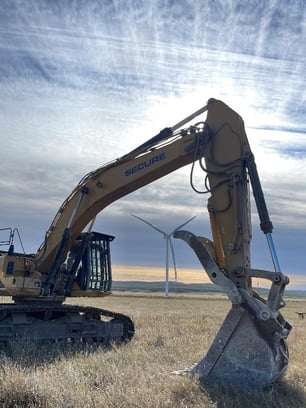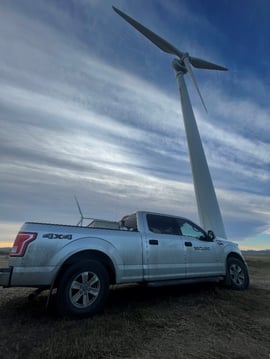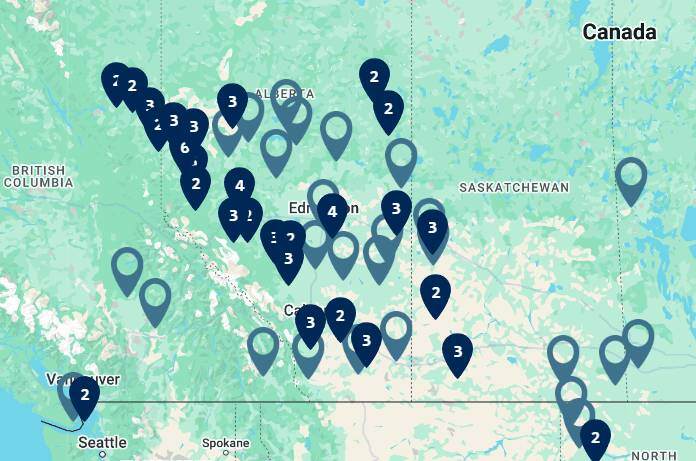At SECURE, we offer a diverse suite of solutions, across the energy, environmental, and industrial sectors, designed to meet our customers’ needs. As this project exemplifies, even renewable energy projects have an end of life.
In the fall of 2021, SECURE was selected to decommission a non-functioning wind turbine northeast of Pincher Creek, AB. The decommissioning process involved a safe and controlled fall of the tower and the structure was then processed down with specialized demolition equipment and recycled.
SECURE was chosen for the project because of our expertise and commitment to delivering quality work with a safe decommissioning execution strategy.
We provided our customer with full site decommissioning services including a solid safety plan for decommissioning complimented with recycling of the turbine components and remediation and reclamation services on the wind turbine site so that the site could be returned to the municipality.
The End of an Era
SECURE’s customer needed a wind turbine decommissioned and the lease returned to the municipality, as it had reached the end of its useable lifespan. Previously on the property, there had been seven vertical axis wind turbines that had been removed over the years by another company, however, the concrete foundations remained, and their removal was included in the scope of work.

Due to the age and condition of the wind turbine, decommissioning through disassembly was not possible. After careful consideration, decommissioning through a controlled fall was chosen as the safest demolition method.
“This turbine was the last one and was also an older generation of direct drive turbine,” says the Sales Coordinator, Jack Ayrton in the Environmental Solutions Division. "Typically, wind turbines have a lifespan of up to 20 years."
Based on SECURE’s previous experience of completing controlled falls of towers and vessels the team successfully developed a fall plan to drop the turbine in a controlled manner.
Making the Plan
Many factors had to be taken into consideration to guarantee that the structure was decommissioned safely and effectively.

To protect the environment, the team sampled and removed oils in the windmill's transformer to ensure that when the structure fell, there would be no possibility of a spill or release. All ancillary equipment and structures were removed from the area to ensure a clear and safe drop zone. The team also discovered an older transformer that contained Polychlorinated Biphenyls (PCBs) and safely removed the PCB oil and disposed of it utilizing a specialized disposal process.
The site was to be returned to a municipal grazing lease upon completion of the decommissioning and careful attention was needed to ensure that the decommissioned site would meet these criteria.
Reclamation work needed to consider the removal and backfilling of the current wind turbine foundation, and the underground foundations remaining from the additional seven turbines once located on the same lease.
Location, Location, Location
Wind speed was a major factor in executing a controlled fall plan. The team had to wait for the wind to be within the allowable tolerances to ensure the fall would go as planned. The concrete footings from the former wind turbines were removed during the downtime when the wind didn't cooperate. When it was calm enough, the turbine was decommissioned by cutting the bolts on the turbine's base flange and applying pressure to the structure's main column with cables. Just enough of a pull was required until gravity took over and it could topple into the planned drop zone.
Once the turbine was on the ground, it was disassembled and processed utilizing specialized demolition equipment. All metals were then recycled at SECURE's metal recycling facility. Ferrous (contains iron) and non-ferrous metals were sorted and separated to ensure that we received the highest scrap metal credits to help offset demolition costs for our client. All concrete from the foundation removal was recycled locally. SECURE’s waste disposal component was minimal as non-recyclable materials were limited to just the turbine blades.
SECURE’s Senior Project Manager, Jeff Thompson, oversaw the decommissioning and explained, "all steel (85 tonnes) and concrete (800 tonnes) were recycled and only about 20 tonnes of non-recyclable waste was sent to a SECURE partner landfill in Pincher Creek."
Looking Forward
When we think of renewables, we don't necessarily think of the limited lifespan of renewable technology, yet there is a growing need within the industry to service and decommission these structures, remediate the land and recycle the material.
Being a smaller project, this windmill decommissioning served as a great opportunity to learn about the intricacies specific to these projects. That said, there are many more windmills that will need to be decommissioned in the future.
SECURE not only took down the aging infrastructure, but recycled the materials where possible. The benefit behind this is that companies can recoup some of the value from the windmill by recycling a portion of the metals. A portion of the demolition cost in this project was recuperated through scrap metal credit returns, providing both a cost-effective and ESG-focused solution.
SECURE is currently applying the same principles from this project on a larger wind farm demolition in Saskatchewan, where 16 towers are being retired. SECURE is providing the full decommissioning of the wind farm, including removal of the equipment, disposal of components (including salvaging and recycling) and the full site reclamation.
Find out how SECURE can help you with demolition and decommissioning here.






